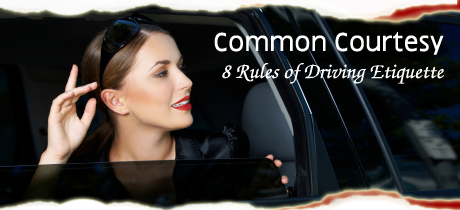
Common Courtesy – Eight Rules of Driving Etiquette
You might say there are two sets of road rules. The first is the body of laws, enforced by the government, that dictate how we should drive. For example: “On a two-way road, drive in the right lane.” These laws are fairly straight forward and aim to eliminate chaos and promote safety. The second set of road rules is mostly unspoken. At times these tacit rules may overlap with driving law, but most motorists understand that driving etiquette, when followed by all, makes the road simpler and safer for everyone. Unfortunately, not everyone chooses to follow this etiquette. Below are eight rules of driving etiquette that can reduce your driving stress and get you to your destination safely.
-
Don’t cruise in the passing lane. In a multi-lane road, highway or freeway, the left lane is the passing lane. Use it to pass a slower vehicle and then return to your original lane. You may not be the fastest vehicle on the road, and blocking the passing lane can cause traffic to back up behind you.
-
Don’t use cruise control when passing a vehicle. When you pass another car, do so quickly. Setting your cruise control to only two miles per hour faster than the driver you’re passing is just as obstructive as driving in the left lane at all times.
-
Turn off your high beams for oncoming traffic. High beams are a helpful feature when driving at night. They allow you to see further down the road than typical headlights, which gives you more time to react to potential hazards. Unfortunately, these bright lights can also blind drivers traveling in the opposite direction. A good driving etiquette tip is that if you can see a set of headlights, turn off your high beams.
-
Keep a safe distance from the driver ahead. In other words, don’t tailgate. It’s not only poor driving etiquette, but tailgating also greatly reduces your reaction time and can cause you to slam into the vehicle in front of you if it stops quickly.
-
Do not stop at the end of on-ramps; merge with the flow of traffic. This may seem difficult on days when traffic is thick, but most on-ramps are long enough to allow you to match the flow of traffic and merge into place. Stopping at the end of the ramp not only makes it more difficult to merge, it holds up the vehicles behind you.
-
Signal before changing lanes or turning. Always use your car’s signals to announce your intentions. Turning or changing lanes without signaling can cause other motorists driving stress and potentially cause an accident.
-
Focus on driving. Texting, talking on the phone, eating, drinking, applying makeup or reaching for items in the backseat all distract you while driving. Keep your eyes on the road and your hands on the wheel to avoid a careless accident.
-
Following a fender-bender, move your vehicle to the side of the road. If you’re not seriously harmed as the result of an accident, quickly assess the damage to your vehicle and, if it’s minor, move the vehicle to the side of the road. Once away from traffic, you can contact the police and insurance company, as well as exchange car insurance policy information with the other driver.
|